
For most people, their home is their sanctuary. It’s a place to feel safe, secure, and totally at ease; its four walls shelter its owners from the hustle, bustle, and, occasionally, the dangers of the outside world. We love that feeling of protection so much, in fact, that the value of the global home security market is expected to skyrocket to $47.75 billion by 2023. The demand for modern home security solutions is showing no signs of slowing down, so as the entire world rides the technological wave of video doorbells and smart cameras, we wanted to explore how the average person protects their space. We surveyed urban, suburban, and rural Americans across three generations to learn how serious they take their home security. Continue reading to see what we learned.
Doorbells, cameras, and alarms, oh my!
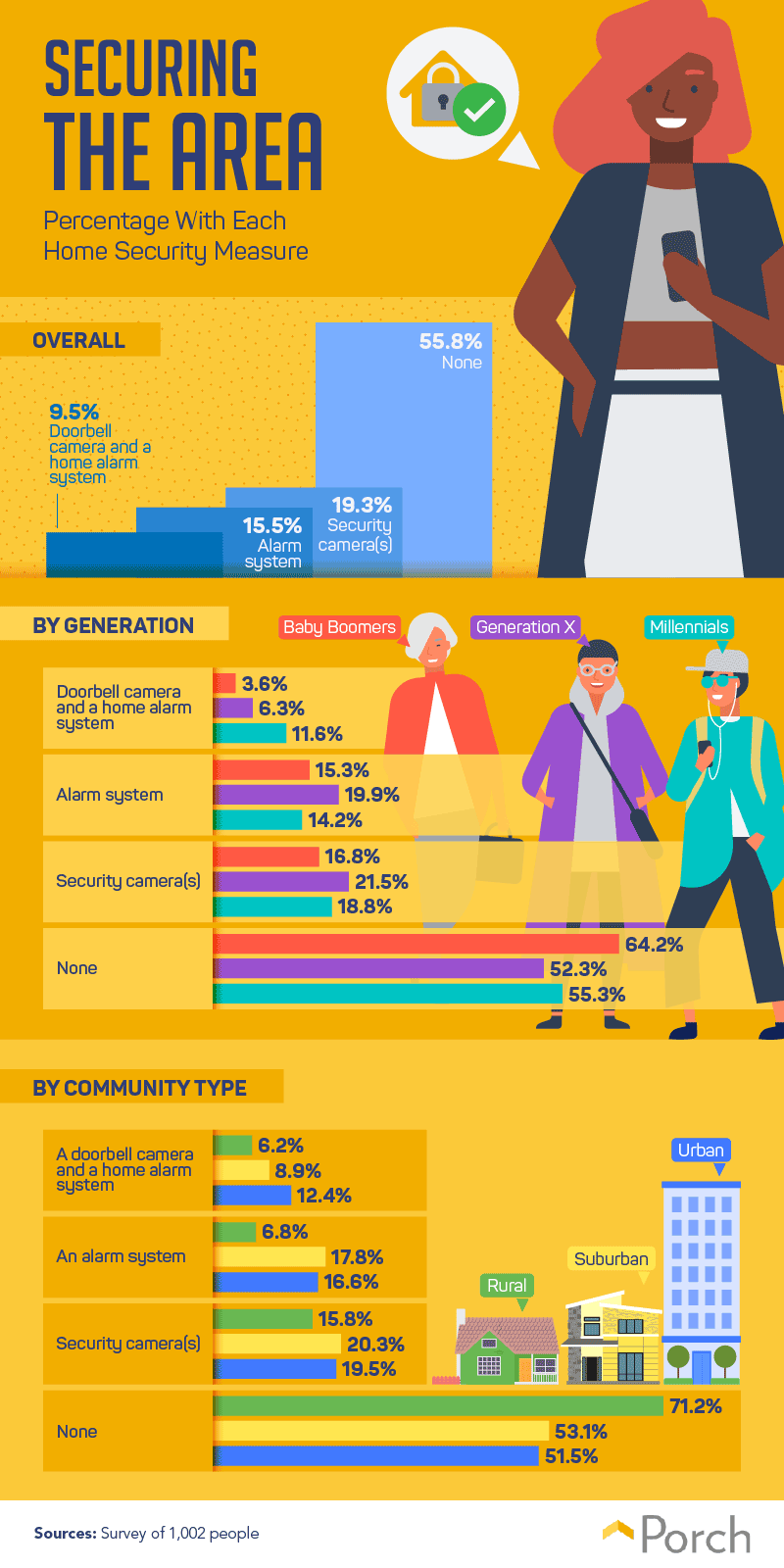 From spotlight-equipped security cameras to smart locks that can grant special access to Amazon delivery people, there is no shortage of new security accessories to catapult your home into the 21st century. But are people really using these gadgets, or are they kicking it old school? The bulk of our respondents weren’t overly concerned with setting up a surveillance system beyond a simple lock and key: Over 55 percent said they did not rely on security cameras, an alarm system, or a doorbell camera for security. Along generational lines, millennials were more likely than their baby boomer and Gen X counterparts to rely on a doorbell camera, while more Gen Xers than either generation reported using alarm systems and security cameras. The majority of baby boomers used none of these tools. Meanwhile, when we sliced the data by community type, respondents in rural areas were significantly more likely than urban and suburban dwellers to not use a home security system (71.2 percent versus 51.5 and 53.1 percent, respectively). While some might picture out-of-town living as an idyllic lifestyle that is nearly immune to crime, in 2018, the rural crime rate actually rose above the national average for the first time in 10 years.
From spotlight-equipped security cameras to smart locks that can grant special access to Amazon delivery people, there is no shortage of new security accessories to catapult your home into the 21st century. But are people really using these gadgets, or are they kicking it old school? The bulk of our respondents weren’t overly concerned with setting up a surveillance system beyond a simple lock and key: Over 55 percent said they did not rely on security cameras, an alarm system, or a doorbell camera for security. Along generational lines, millennials were more likely than their baby boomer and Gen X counterparts to rely on a doorbell camera, while more Gen Xers than either generation reported using alarm systems and security cameras. The majority of baby boomers used none of these tools. Meanwhile, when we sliced the data by community type, respondents in rural areas were significantly more likely than urban and suburban dwellers to not use a home security system (71.2 percent versus 51.5 and 53.1 percent, respectively). While some might picture out-of-town living as an idyllic lifestyle that is nearly immune to crime, in 2018, the rural crime rate actually rose above the national average for the first time in 10 years.
To DIY or not to DIY?
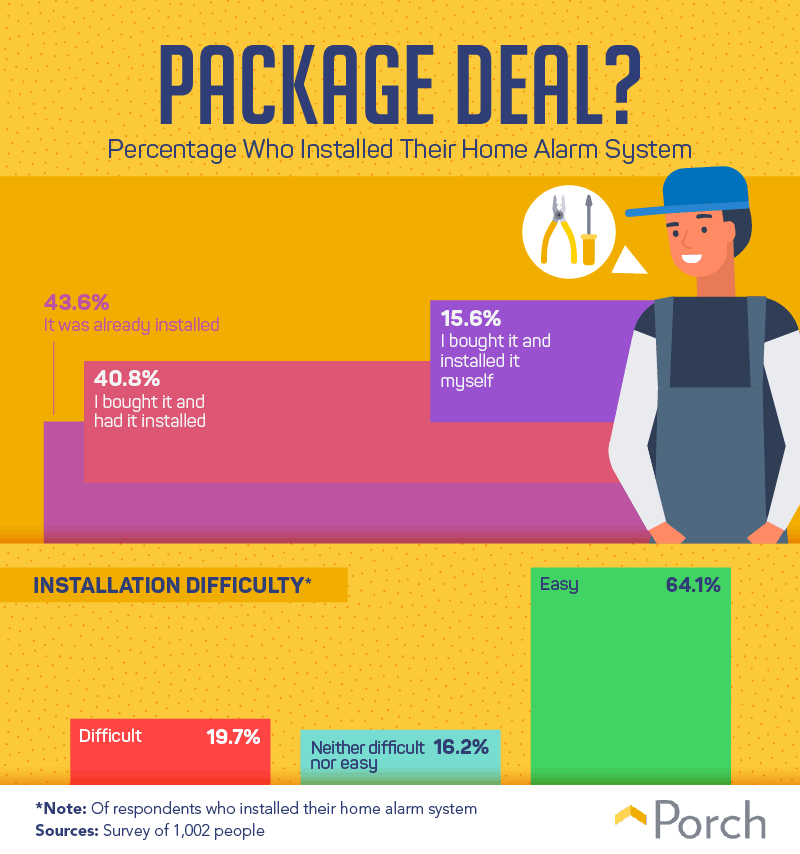 When you’re on the hunt for a new home, there is a laundry list of pitfalls—from uneven tiling to mold—and lifestyle considerations to think about before making a final call. So while you’re at it, why not poke around and see if there’s an existing home security system? Nearly 44 percent of respondents said their house already came with an alarm system—that’s one thing checked off the never-ending move-in list! Another 40.8 percent said they had a professional install one for them, while 15.6 percent did it themselves. Around 64 percent of respondents said installing an alarm system was easy. However, if you simply don’t have the time or energy, have no fear—a professional is never far away.
When you’re on the hunt for a new home, there is a laundry list of pitfalls—from uneven tiling to mold—and lifestyle considerations to think about before making a final call. So while you’re at it, why not poke around and see if there’s an existing home security system? Nearly 44 percent of respondents said their house already came with an alarm system—that’s one thing checked off the never-ending move-in list! Another 40.8 percent said they had a professional install one for them, while 15.6 percent did it themselves. Around 64 percent of respondents said installing an alarm system was easy. However, if you simply don’t have the time or energy, have no fear—a professional is never far away.
Home vs. financial security
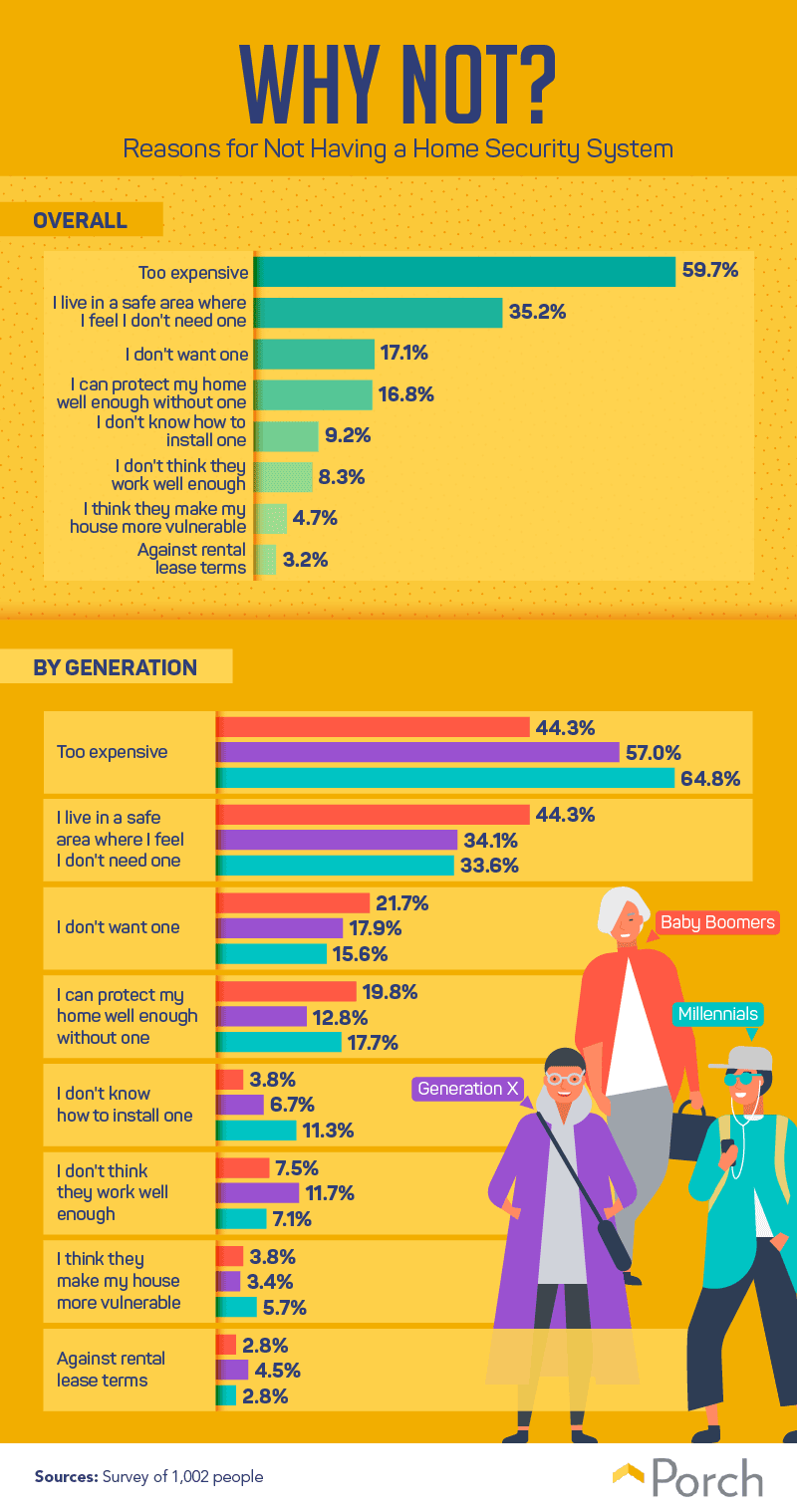 The No. 1 reason our respondents elected not to install a home security system was cost. Nearly 60 percent said this technology was simply too expensive, with millennials citing cost as an issue at a higher rate than Gen Xers and boomers. Another 35.2 percent felt they lived in a safe enough area that they didn’t need a security system to protect them. While the two younger generations felt much more strongly about cost issues, an identical number of baby boomers named cost and a feeling of neighborhood safety as the main drivers behind their choice to forgo a camera or alarm (44.3 percent in both cases). Even in the safest areas, a home security system is helpful for many reasons beyond deterring or detecting intruders, includinghome insurance savings and having peace of mind while you’re out of the house.
The No. 1 reason our respondents elected not to install a home security system was cost. Nearly 60 percent said this technology was simply too expensive, with millennials citing cost as an issue at a higher rate than Gen Xers and boomers. Another 35.2 percent felt they lived in a safe enough area that they didn’t need a security system to protect them. While the two younger generations felt much more strongly about cost issues, an identical number of baby boomers named cost and a feeling of neighborhood safety as the main drivers behind their choice to forgo a camera or alarm (44.3 percent in both cases). Even in the safest areas, a home security system is helpful for many reasons beyond deterring or detecting intruders, includinghome insurance savings and having peace of mind while you’re out of the house.
Kitchen knife crusaders
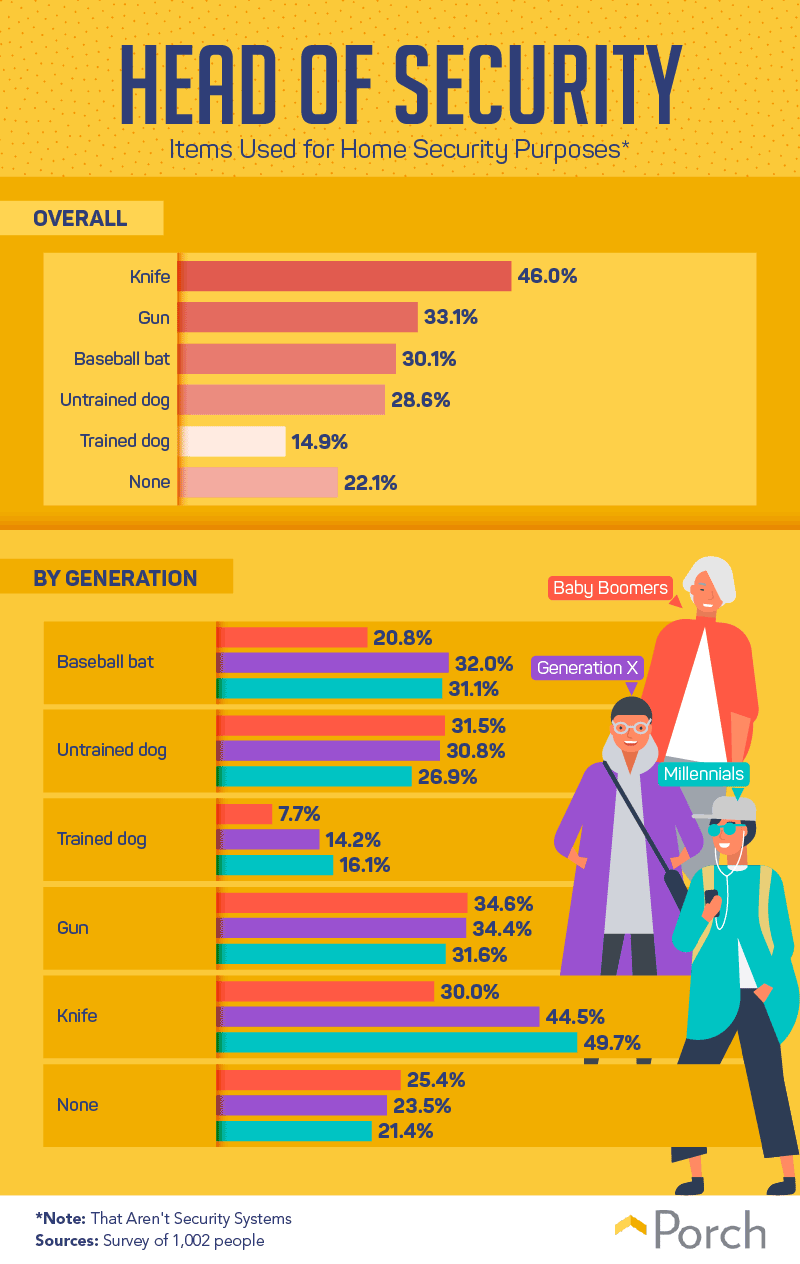 Alarm systems aside, our respondents got fairly creative with their homemade security measures. Their weapon of choice? Knives, with 46 percent of people saying they intended to use this type of tool for defense in the event of an incident. Guns, baseball bats, and untrained dogs followed in close succession, while 22.1 percent of respondents said they weren’t interested in using any alternative household weapon to defend themselves. It’s important to note that any device used to harm someone (especially a firearm) requires a certain degree of familiarity and training to be used safely and responsibly—especially in the heat of the moment. The willingness to use any given item yielded a similar percentage of people from each generation, although millennials were particularly keen on knives, while baby boomers most often utilized a firearm or an untrained dog.
Alarm systems aside, our respondents got fairly creative with their homemade security measures. Their weapon of choice? Knives, with 46 percent of people saying they intended to use this type of tool for defense in the event of an incident. Guns, baseball bats, and untrained dogs followed in close succession, while 22.1 percent of respondents said they weren’t interested in using any alternative household weapon to defend themselves. It’s important to note that any device used to harm someone (especially a firearm) requires a certain degree of familiarity and training to be used safely and responsibly—especially in the heat of the moment. The willingness to use any given item yielded a similar percentage of people from each generation, although millennials were particularly keen on knives, while baby boomers most often utilized a firearm or an untrained dog.
Lock around the clock?
.png) If you have a front door, chances are that it has a lock on it, making the deadbolt a near-universal baseline defense against unwelcome visitors. However, no matter where our respondents lived, the majority opted not to lock their door if they were at home. Urban and suburban Americans reported similar habits: 60 percent of suburbanites and 55.7 percent of urbanites said they kept the front door unlocked when at home, while less than a third of each left the door unlocked while away. Rural respondents, on the other hand, were more likely to do both. Nearly 70 percent ditched the deadbolt if they were home, while another 31.6 percent didn’t mind leaving the door unlocked even when out and about. No matter how safe your neighborhood is, locking your doors and windows is still the best and simplest way to prevent a break-in. Before taking drastic measures like shattering a window, thieves will oftentest the lockon the front door as a no-force point of entry.
If you have a front door, chances are that it has a lock on it, making the deadbolt a near-universal baseline defense against unwelcome visitors. However, no matter where our respondents lived, the majority opted not to lock their door if they were at home. Urban and suburban Americans reported similar habits: 60 percent of suburbanites and 55.7 percent of urbanites said they kept the front door unlocked when at home, while less than a third of each left the door unlocked while away. Rural respondents, on the other hand, were more likely to do both. Nearly 70 percent ditched the deadbolt if they were home, while another 31.6 percent didn’t mind leaving the door unlocked even when out and about. No matter how safe your neighborhood is, locking your doors and windows is still the best and simplest way to prevent a break-in. Before taking drastic measures like shattering a window, thieves will oftentest the lockon the front door as a no-force point of entry.
Surveilling future trends
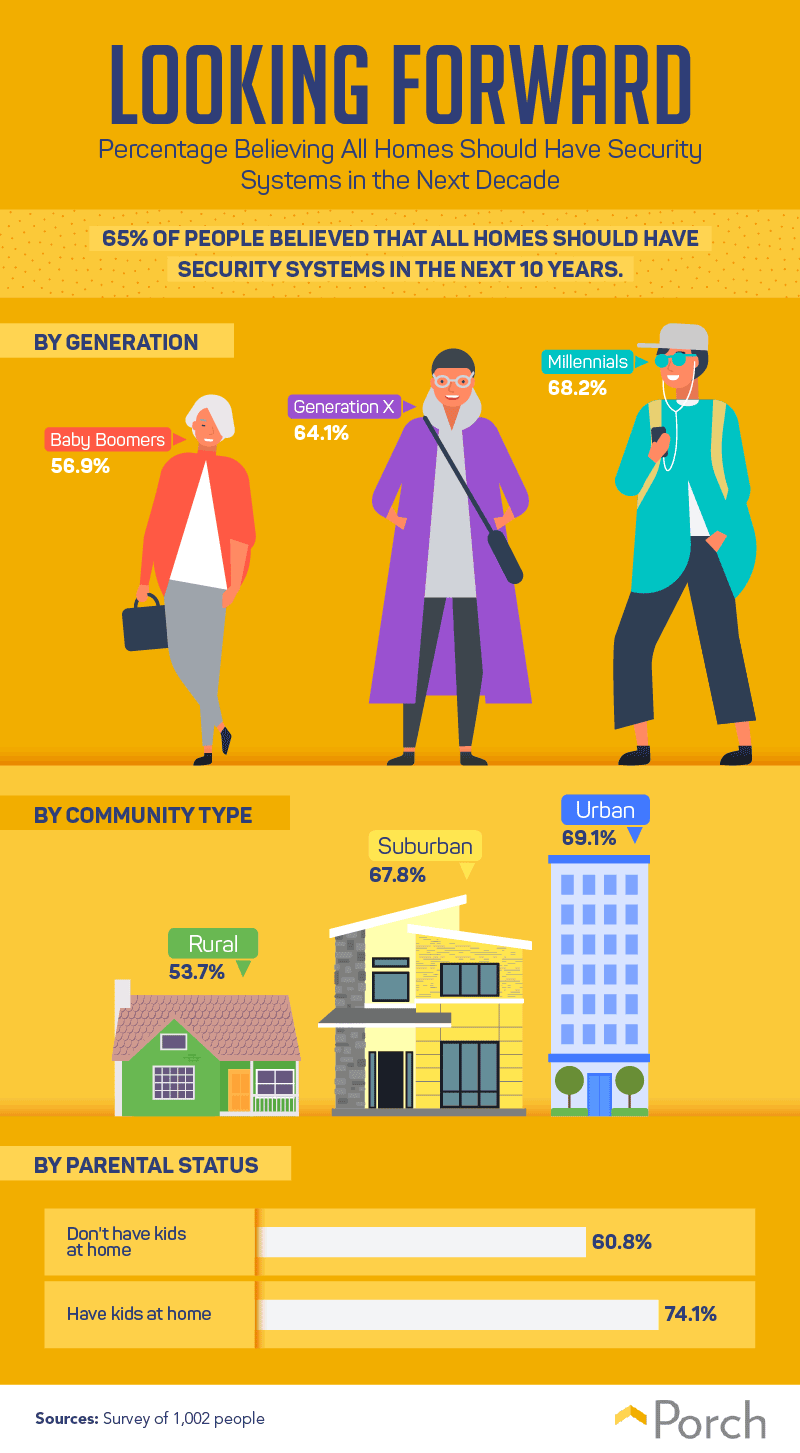 The world of home security is changing, as more and more innovative products hit the market, like AI-powered surveillance solutions that rely on geofencing, facial recognition, and the like. With their sights set on the future of home security, 65 percent of respondents believed all homes should be equipped with a system in the next decade. Respondents with children living at home were more likely to feel this way, compared to those without (74.1 percent versus 60.8 percent). Meanwhile, baby boomers and people living in rural areas were the least likely to feel the need for universal home security, while Gen Xers and suburbanites found themselves in the middle. Meanwhile, urban dwellers and millennials touted the importance of home security systems the most.
The world of home security is changing, as more and more innovative products hit the market, like AI-powered surveillance solutions that rely on geofencing, facial recognition, and the like. With their sights set on the future of home security, 65 percent of respondents believed all homes should be equipped with a system in the next decade. Respondents with children living at home were more likely to feel this way, compared to those without (74.1 percent versus 60.8 percent). Meanwhile, baby boomers and people living in rural areas were the least likely to feel the need for universal home security, while Gen Xers and suburbanites found themselves in the middle. Meanwhile, urban dwellers and millennials touted the importance of home security systems the most.
Home sweet home
Our homes protect us, so it’s only fair we protect them too. While the tried-and-true front door lock was the most common way for our respondents to safeguard their houses, security cameras and alarm systems were also used by approximately one-fifth of the population. The main reason people opted not to use a home security system was cost, followed by feeling safe enough without one. On the whole, those living in rural areas tended to be more lax about locking their doors, while urbanites and suburbanites were more prone to locking up. Looking forward, a majority of respondents from all walks of life said they thought all homes should be hooked up to a monitoring system in the next decade. While installing a home security system might be easy, most home renovations require the steady hand of a professional. With Porch, you can find a handyperson for any home improvement job under the sun, from HVAC to painting and winterization. Visit Porch today to browse dozens of different project types and find a trusted pro!
Sources
- https://www.securitysales.com/news/forecast_global_home_security_market_to_be_worth_47-5b_by_2020/
- http://www.shield-security.com/hs-fs/hub/208616/file-1882657287-pdf/Smart_Home_Security_Report_.pdf
- https://www.engadget.com/2018/12/03/arlo-ultra-4k-security-camera/
- https://www.engadget.com/2018/11/07/schlage-connect-smart-deadbolt-zigbee-amazon-key/
- https://thecrimereport.org/2018/05/14/rural-violent-crime-rate-rises-above-u-s-average/
- https://www.realtor.com/advice/buy/things-to-look-for-when-buying-a-home/
- https://www.opendoor.com/w/guides/what-to-look-for-when-buying-a-house
- https://www.asecurelife.com/reasons-to-install-home-security-system/
- https://www.urmc.rochester.edu/encyclopedia/content.aspx?ContentTypeID=85& ContentID=P00833
- https://elephantalarms.com/en/blog/tips/224-safety-tip-1-why-you-should-always-lock-all-the-window-and-door-locks
- https://www.nytimes.com/2018/06/29/your-money/artificial-intelligence-home-security.html
- https://www.iii.org/article/twelve-ways-to-lower-your-homeowners-insurance-costs
- https://www.rd.com/home/improvement/burglar-secrets/
- https://www.prnewswire.com/news-releases/worldwide-analysis-on-the-smart-home-security-market-2013-2023-2019-edition-a-robust-growth-of-15-56-cagr-is-anticipated-300813267.html
Methodology and limitations
To gather the data presented above, a survey was ran using Amazon’s Mechanical Turk Service. 1,002 people were surveyed in total about the state of security measures they’ve taken at home. Of those respondents, 491 were men, and 511 were women. 137 were baby boomers, 256 were from Generation X, and 584 were millennials. All data presented above rely on self-reporting, which can be host to issues like telescoping and exaggeration. To combat these issues, an attention check was used to ensure that only participants who paid full attention were allowed to proceed with the survey. For the section regarding why respondents didn’t have a security system, the option for “in an apartment/against terms of lease” was not presented as an option but rather written in. If it had been presented as an option for respondents, percentages might have been higher for it.
Fair use statement
This article has an open-door policy! Feel free to share our findings with friends, colleagues, and family for noncommercial purposes—all we ask is that you link back to our original work so that everyone can get the full story.
